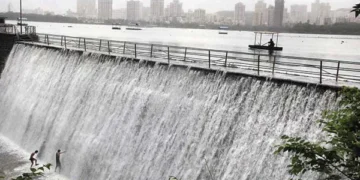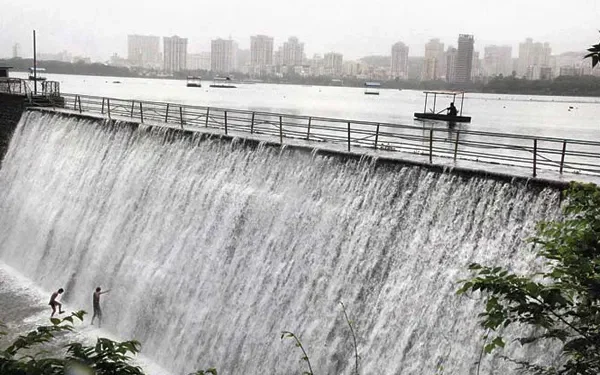Powai Lake in Mumbai overflows following relentless rainfall; dramatic visuals capture the rising water levels and impact on the surrounding areas.

Since the beginning of the week, Mumbai and its surrounding regions have been lashed by heavy rainfall, resulting in severe waterlogging in several low-lying areas and causing widespread traffic snarls. In the early hours of Wednesday, Powai Lake — one of the city’s key artificial reservoirs maintained by the Brihanmumbai Municipal Corporation (BMC) — began to overflow.
The Brihanmumbai Municipal Corporation (BMC) shared a video on its official X (formerly Twitter) handle showing Powai Lake overflowing. The post stated that the artificial lake, which has a storage capacity of 545 crore litres (5.45 billion litres), began overflowing around 6 a.m. due to heavy rainfall in its catchment area over the past two days.
Currently, the water level stands at 195.10 feet. While the lake’s water is non-potable, it is primarily used for industrial purposes and for non-drinking use in the Aarey Milk Colony.
A torrential downpour severely disrupted Mumbai’s transport network on Monday, causing delays on both Central and Western Railway suburban lines. Commuters faced wait times of 20 to 30 minutes during the busy morning rush.
Powai Lake, a popular recreational spot nestled amid lush greenery and high-rises in the Powai area, has begun overflowing 20 days earlier than it did last year.
When at full capacity, the lake covers a surface area of approximately 2.23 square kilometres, with a catchment area spanning 6.61 square kilometres.
Table of Contents
Situated 27 kilometres from the Brihanmumbai Municipal Corporation (BMC) headquarters, this historic lake was constructed in 1890 at a cost of Rs 12.59 lakh.
Seven reservoirs — Bhatsa, Upper Vaitarna, Middle Vaitarna, Tansa, Modak Sagar, Vihar, and Tulsi — collectively supply 3.85 billion litres of drinking water daily to the megacity.















 Categories
Categories









